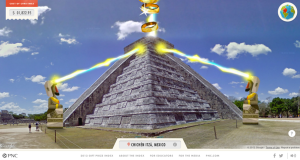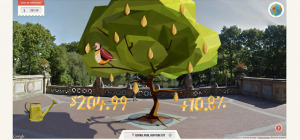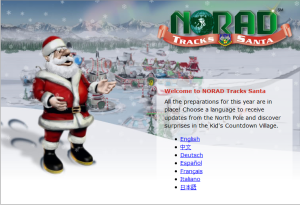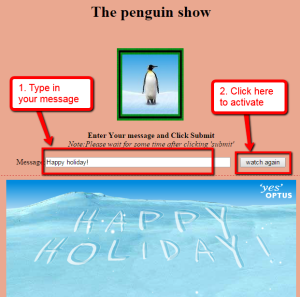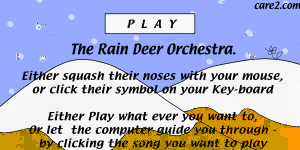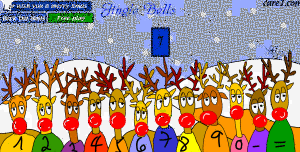 Here are five great holiday websites that will put the seasonal spirit into your teaching. They are education-infused, lively, and appeal to varied learning styles. If you’re a tech teacher, you’ll want to use all of them. If you’re a classroom teacher, click through and find the ones right for your age group:
Here are five great holiday websites that will put the seasonal spirit into your teaching. They are education-infused, lively, and appeal to varied learning styles. If you’re a tech teacher, you’ll want to use all of them. If you’re a classroom teacher, click through and find the ones right for your age group:
12 Days of Christmas
Middle School and High School
Overview
Students uncover the true cost of Christmas as they travel around world, play critical thinking games, and uncover data required to answer the question: What is the true cost of the 12 Days of Christmas? Based on the whimsical Christmas Price Index®, this game is used in classrooms around the world as an entertaining introduction to basic economic concepts.
No log in is required. Simply click the link to access the website, wait until it loads, board the train, and get started.
The train stops at locations that coincide with the song, 12 Days of Christmas. At each spot, students collect a gift by playing a problem-solving game.
When they complete the location’s activity, they uncover the current cost of that gift as well as the price change from the prior year. For example, in the image below, a partridge in a pear tree costs $184.99, a 14.2% increase from the prior year:
If students can’t figure out one of the games, they can move on to the next and come back to this difficult one later. By the end of the train ride, students have collected all twelve prices and differentials.
All games are intuitive, easily solved with a guess-and-check approach, which makes them simple enough for younger students. The concepts, though, are solidly middle and high school. Created by the inventors of the Stock Market Game, expect a gamified economics lesson that students will be in charge of and won’t want to quit until they have completed all the activities.
Pros
The graphics are stunning. The program is colorful and animated, with great music and sound effects that make the experience even better.
No advertising. This site was created by a financial institution, but they don’t flaunt themselves at every click. Nicely done, PNC!
There’s a moderate but palatable learning curve–intentional–to encourage students to think critically and outside the box. They quickly realize it feels good to solve puzzles.
Cons
It takes a while to load. Warn students so they don’t give up.
Insider tips
If you see students getting frustrated with the economics or having difficulty transferring data to a spreadsheet, pair them up.
While this–like the other two in the series (Gift Hunt and Gift Maker)–is intended for middle and high school students, I have successfully used it with 4th and 5th graders by having them focus on the economic standards appropriate for their age group. This has the added benefit of accommodating precocious students who find lots of opportunities to dig deeper in the middle school concepts.
Play the song, 12 Days of Christmas, while students are working. Here’s a nice version from Hoopla Kids.
Educational Applications
Use this game to inspire an age-appropriate discussion on inflation and economic trends. Similarities to the U.S. Consumer Price Index make it an authentic activity.
For those not ready for economic trends, use it to motivate critical thinking.
Have students track gift prices using a simple spreadsheet like this one:
Conclusion
This site could imbue Scrooge with the holiday spirit. It is a solid addition to your holiday learning toolkit.
Design: 5/5
Functionality: 5/5
Fun Factor: 5/5
Availability: 3/5 (Web)
Overall: 5/5
Middle School and High School
Overview
The twelve gifts of Christmas have disappeared. Students must travel the globe to locate them and calculate their true cost. Gift Hunt uses Google Street View to take you on an interactive adventure across five continents as you track down each of the gifts and find out how much they cost in 2012 (the game is updated yearly–this is the 2012 edition of 12Days of Christmas).
The site combines the photography and functionality of Street View with charming character animation, authentic sounds effects, and enticing music to create a novel and immersive game experience. Students can visit the site from desktops, laptops, tablets and smart phones.
Pros
This site uses the game approach students natively understand.
It’s created by PNC, a knowledgeable expert in the financial field and creator of other economic learning games (including 12 Days of Christmas) that have been well received by the education community.
Sometimes, it didn’t work in my Firefox browser. I had to switch to Chrome.
Educational Applications
This is a great tool for teaching economics, market forces, and the mechanics of the price index to middle and high school consumers. If students played last year’s game, let them start this one with only a short introduction.
Make sure they keep a spreadsheet program close by to collect their data.
When students complete Gift Hunt, have them visit the next iteration in the series, Gift Maker. It has a ‘maker’ approach to evaluating economic trends through the vehicle of interactive activities, a Flash presentation, MP3 downloads and more.
Conclusion
Include this on your list of gamified teaching tools for economics, right next to Stock Market Game and Financial Football.
Design: 5/5
Functionality: 5/5
Fun Factor: 5/5
Availability: 3/5 (web)
Overall: 5/5
K-5
Overview
Published by the North American Aerospace Defense Command (NORAD), this eagerly-anticipated annual collection of holiday games started as a mistake in 1955…
On Dec. 24, 1955, a call was made to the Continental Air Defense Command (CONAD) Operations Center in Colorado Springs, Colo. However, this call was not from the president or a general. It was from a girl in Colorado Springs who was following the directions in an advertisement printed in the local paper – she wanted to know the whereabouts of Santa Claus.
The ad said “Hey, Kiddies! Call me direct and be sure and dial the correct number.” However, the number was printed incorrectly in the advertisement and rang into the CONAD operations center.
On duty that night was Colonel Harry Shoup. He received numerous calls that night and rather than hanging up, he had his operators find the location of Santa Claus and reported it to every child who phoned in.
Thus began a tradition carried on by the North American Aerospace Defense Command (NORAD) when it was formed in 1958.
The website opens with lively traditional holiday music and several options (like an introductory video and a Santa tracker that is not active until December 24th)…
…including a link to Santa’s Village, a collection of twenty-four G-rated, non-violent, K-5 games–critical thinking required. From December 1st through the 24th, one game a day is added like a virtual Advent Calendar. Students must know which day it is and find the corresponding number to select an open game.
To the accompaniment of toe-tapping holiday music, students play holiday versions of popular kids’ games such as tic-tac-toe, Zippy Elf Word Sleuths, the Game Room, Ornament Collection, sledding, Christmas Putt and Play, and Snowball Warrior.
The favorite of my students is Light the Christmas Tree. Students must rotate the black elbows until all are connected and the tree explodes with brightly-lit bulbs.
Success requires logical thinking and if-then analysis. I have seen few adults complete it, but lots of first and second graders. In fact, they race to see who can do it the fastest (and they are quick. It took one boy ninety seconds. I asked him how he did it. His answer: My dad told me to look backwards for the answers and that’s what I did. Wow. Another instance of me learning from my students).
On Christmas Eve, this site tracks Santa’s progress as he delivers gifts across the planet. I share this with parents so they’ll know when to get their kids in bed, allowing Santa to arrive in private.
Pros
No advertising.
It’s intuitive with a minimal learning curve.
I like that the games are numbered, not named. This makes it more user-friendly for the target age group.
Cons
Students can only access one new game a day. This is only a negative for youngsters who are used to clicking and having everything at their fingertips.
Insider tips
The ‘Santa’s Village’ link was a tad difficult to find on the start page. If that’s a problem again this year, provide some direction (such as, scroll down the page to ****).
The video is well done, but presented through YouTube. I remind students to go nowhere other than the selected NORAD video. That’s fine–I need these opportunities to teach digital citizenship.
Educational Applications
All games are educational with problem solving opportunities.
If you play Light the Christmas Tree, have students who successfully connect all lights print a screen shot (you may have to teach them how to do this), sign it, and hang it in the classroom gallery. Here’s a picture from my collection. This was one of many first grader successes:
My students are always disappointed that they can’t play this game out of season. In September, I appoint one student to remind me on December 1st that the site is open.
Conclusion
Even though I faze students out of this by 3rd grade, they continue to play it on their own. NORAD does a great job of keeping the Christmas joy and wonder alive for children.
Design: 5/5
Functionality: 5/5
Fun Factor: 5/5
Availability: 3/5 (web-based only)
Overall: 5/5
K-5
Overview
This site is as close to sluicing down an icy mountainside on your stomach, arms tucked for aerodynamics, wind whistling past your ears–with a penguin as guide–as you can get. Program the penguin and he does the rest, all to the sound of festive music that’s so much like the Lion King’s “Hakuna Matata”, it must have been written by the same artist.
Here’s how it works: You type a message into the website for your penguin to write onto the slope and push send. A penguin appears atop a cold snow-covered peak, limned against the pristine winter sky. He analyzes his task, picks the best route downhill, throws himself onto his stomach, and is off.
He swerves and jukes his way down the mountain’s face, ice crystals crunching beneath his belly, wind howling through his feathers, as he scores your message into the ice-and-snow-laden surface:
When finished, it might look like this:
This always works and is easily shared by posting a link to a blog or wiki. No embed, but there are ways to work around that.
Pros
I am always eager to find fun and unique ways to intrigue students about technology. This qualifies. I usually line up four-five holiday websites and give students 15-20 minutes the last few days of class (before the holiday break) to play. Penguin Show–because of the personal touch and its addicting music–is always a favorite.
Cons
The learning curve is surprisingly tricky for such a quick tool. The developers don’t explain the process well, which leaves several spots where users can stumble. Still, when it works, it makes up for difficulties.
It’s only available on the web. Since the site hasn’t changed since I started using it five years ago, I don’t believe there are any plans to expand the penguin’s reach this year.
Insider tips
To play, 1) enter your message (i.e., Happy holiday!) and 2) click ‘Watch again’.
If you have problems getting the ‘show’ to appear in your browser, switch browsers. For me, Firefox is problematic, but Chrome always works.
Educational Applications
This site is perfect for the holidays when you want to slow things down a bit, as well as during annual assessments when students need an injection of humor. I have several like this (check out Dancing Ponies, a Biplane Tour of America, and how to clean your monitor). I use these as reminders that tech and creativity go hand-in-hand.
Use this during a first grade penguin unit. Discuss whether a real penguin could do what this animation does.
Use as a creative approach to spelling practice, along with other word study sites like GeoGreeting and Spelling City.
Conclusion
Keep Penguin Show on hand throughout the year to reinforce spelling. It always motivates students to practice vocabulary.
Design: 5/5
Functionality: 5/5
Fun Factor: 5/5
Availability: 3/5 (Web)
Overall: 4/5
Reindeer Orchestra
K-3
Overview
This is a fun musical program that teaches mouse and keyboard skills to newly-minted techies. Pick one of three songs (Deck the Halls, Jingle Bells, or We Wish you a Merry Christmas) or compose your own music. Once you have made your selection, a number appears over one of the reindeer. Squeeze his nose or type the number on the keyboard and hear the note, and then repeat the process with each number as it appears over a new reindeer. Played in this numbered order, you hear the selected song.
The music is a cappello, with the single voice a musical instrument (sounds like a tuba or a bassoon).
Colors are bright, the snow constantly falls, and the reindeer anthropomorphically approve of your musical efforts.
Pros
This is a holiday site that appeals to a wide range of ages. I’ve played it with kindergarten and 8th graders and all are transfixed.
I appreciate that there are no ads, just the game.
Because the selections include three popular songs, most students will go through all of them before moving on to another activity.
Cons
It’s difficult to keep up the traditional pace of these songs with mouse clicks. The music comes out fairly disjointed even for me. Still, that doesn’t seem to bother my students.
It’s only available on the web–no iPad or smartphone versions yet.
Insider tips
When the program says to squeeze the reindeer nose, that’s exactly what it means. Don’t get close–say, poke them in the eye or pat their stomach or hover. Nothing happens.
Encourage students to use the number pad rather than a mouse click to squeeze the reindeer’s nose. This keeps the musical pace closer to the real song.
Educational Applications
This game is a festive and authentic way to practice mouse skills and number recognition for kindergarten and 1st grade during the holiday season. It’s also a great connection between music and tech.
Use this as one of several websites students play as the holiday break approaches. If you have a school concert, consider adding this musical keyboard to the agenda.
Conclusion
Add this to the list of sites available to students when the December break is so close, they lose the ability to listen.
Design: 5/5
Functionality: 5/5
Fun Factor: 5/5
Availability: 3/5 (web)
Overall: 4/5
There you have it–five holiday websites that will make your teaching sparkle. Please leave a comment about your experiences using these programs. I’d love to hear your thoughts!
Jacqui Murray has been teaching K-18 technology for 30 years. She is the editor/author of over a hundred tech ed resources including a K-12 technology curriculum, K-8 keyboard curriculum, K-8 Digital Citizenship curriculum. She is an adjunct professor in tech ed, Master Teacher, webmaster for four blogs, an Amazon Vine Voice, CSTA presentation reviewer, freelance journalist on tech ed topics, contributor to NEA Today, and author of the tech thrillers, To Hunt a Sub and Twenty-four Days. You can find her resources at Structured Learning.







